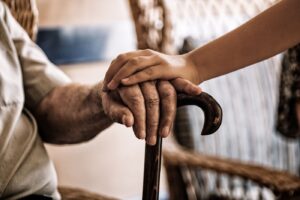The Humanum colloquium on the complementarity of man and woman, which was held at the Vatican in November, drew an audience of top religious leaders from all over the globe. But the talks and movies that came out of the conference aren’t just for priests, pastors, or rabbis—they’re also an incredible resource for parents who are trying to figure out how to talk to their children about family and human sexuality. If parents want to give their children the gift of vision—of seeing God’s divine plan inscribed in human sexuality—they will need to make a preemptive strike against our de-formative culture.
The six short videos produced by the conference organizers are visually beautiful. They weave together images of young married couples embracing on their wedding day with those of older couples surrounded by their children at home. Rodin’s sensual statues appear, alternating with images of the sea and the dry land, the feminine and the masculine. The message is clear: “male and female He created them” is essential to humanity—not just to Christianity, Europe, the West, or some weird fringe band of conservatives in Red States. The Vatican conference featured speakers from twenty-three countries and fourteen different faith traditions, and the video series shows the feminine and masculine as archetypes of every culture of life.
Beyond being visually beautiful, the series is rich in human language. The interweaving of English, Arabic, Spanish, French; the interviews with couples from Nigeria, Mexico, Lebanon; together, they create a rich tapestry that expresses a common human truth. The series becomes an invitation to overcome Babel with the gift of tongues, to learn how to express the beauty of human sexuality in a way that is compelling for the next generation.
Visually beautiful, rich in language—the series is moving and effective, yet it probably could not be grasped by children younger than the eighth grade. Instead, groups of parents could gather to watch the series, as a way of sparking conversations about how to present early and clearly this culture of life to their children. We are awakening to how children’s literature and children’s television and movies have acted as a cultural invasion, reaching even where the long arm of public schooling has been unable to go. Perhaps someone will follow up with more such visually beautiful videos aimed at younger ages.
Start your day with Public Discourse
Sign up and get our daily essays sent straight to your inbox.A Little House with Big Lessons
Meanwhile, one beloved childhood book series that gives a beautiful lesson in complementarity is Laura Ingalls Wilder’s Little House in the Big Woods. The Little House series tells the tale of the Ingalls family’s life on the frontier in the 1870s, but it was written by Laura Ingalls Wilder (a defender of rural life during the New Deal years) and her daughter Rose Wilder Lane (a libertarian) in the 1930s. Over the decades, it became a classic American bedtime story, and Ma and Pa, Laura, Mary, and baby Carrie are familiar household names for many children still. In the 1970s, their books were turned into a television series—reportedly Ronald Reagan’s favorite TV show.
Little House in the Big Woods, the first book in the series, is remarkably well-written, following the seasons—fall, winter, spring, summer—to teach the four cardinal virtues of prudence, justice, fortitude, and temperance. But more importantly, little Laura, who is not a naturally perfect little girl with golden hair like her older sister Mary, learns to embrace her feminine gifts.
The family is introduced in the cover illustration in pairs: Ma holds baby Carrie, Pa holds Mary, and Laura gazes at the doll in her arms. We see the American frontier family as Tocqueville saw it: the equality around the domestic hearth, the more intimate and affectionate natural bonds. Yet parenting is not neutral. Laura learns differently from Ma and Pa how to care for another person. The picture on the first page presents the problem of education, as Mary walks demurely with her perfect ringlets under her bonnet carrying a bouquet of flowers and Laura races ahead, hair disheveled, swinging her hat.
Along with the members of the family, readers are immediately introduced to Jack, their dog, and to Pa’s gun. The gun, the cleaning of the gun, and the purpose of the gun are the first lesson learned. The Big Woods are full of bears, wolves, and wild cats that endanger the family, and the family would starve in the winter if not for the dead deer hanging outside the house in the morning when Laura wakes up. Pa and his gun are essential to the family’s survival.
Pa also tells lots of bedtime stories, which reveal that Laura is like him in more ways than one. Not only does he have brown hair, but he was a little trouble-maker in his childhood. Just as Laura struggles with all the virtues, so does he. Sometimes, he even terrifies the children when he gets too realistic in pretending to be a bear, and Ma has to rebuke him. Pa and his gun, if not virtuously trained, could endanger the little family from within.
Ma’s Voice: Teaching Utility and Beauty
Many feminist readers object to the book because Pa gets to do all the talking and singing and story-telling and educating, with Ma making little approving noises in the background. They grouse that we don’t ever hear Ma’s voice.
This is nonsense of a pretty high order! Most children rejoice in the lessons from the books about how to make butter, cheese, maple syrup candy, how to cure meat and make sausage. In these lessons, Ma’s quiet voice has so powerfully shaped Laura that it has become one with the narrative voice. Listen as Laura says:
Then she mixed the pot-liquor with it, and set it away in a pan to cool. When it was cool it would cut in slices, and that was the headcheese. . . . She put the balls in a pan out in a shed, where they would freeze and be good to eat all winter. That was the sausage.
The patient, proud, satisfied-with-work well-done phrase that concludes each task is Ma’s own voice, which has now become Laura’s narrative tone.
This is especially true when Ma completes her useful work by making it beautiful: “Laura and Mary watched, breathless, one on each side of Ma, while the golden little butter-pats, each with its strawberry and its leaves molded on top, dropped onto the plate.” Ma’s way of dressing for Christmas, Ma’s china shepherdess brought from back east, Ma’s way of setting a pretty table—through these things, Ma trains her family’s eye to be able to see the difference between the beautiful and the ugly, the noble and the base. They are taught to distinguish good from evil and persons from things.
Not only do the children learn to speak with her voice—their mother-tongue—but they see with her eyes. When they go into town for the first time in the spring, Laura observes a woman laying out the washing “though it was not Monday.” That little judgmental voice is so true to the simplicity of childhood, where the culture of the family is the primary and most absolute educator.
In the final chapter, Pa comes home from a hunting trip where he has not shot any deer. Caught by the beauty of a doe and her fawn “stepping daintily out of the shadows” he sat still in contemplation and did not shoot. This time it is Laura, rather than Ma, who whispers approvingly, “I’m glad you didn’t shoot them!” She may not be a naturally virtuous, perfect princess of a little girl like Mary, but she has learned that Ma as well as Pa has an important role in the family. The family is only whole and safe when it is founded on the complementarity of masculine and feminine.
Henry Adams once famously lamented the “Missing Virgin” in American culture, the loss of grandmothers who would really play the role of grandmothers—civilizing the next generation of little hooligans, the creation of a terrifying brave new world that would be as “sexless as the bees.” Perhaps grandmothers might save us yet by taking up their task each bedtime by picking up Laura Ingalls Wilder’s Little House books.












